Populism articulates the political in an oneiric manner, but the project of a political psychoanalysis of populist dreams has proven extraordinarily difficult. A cure is nowhere in sight. Part of the problem for those seeking to oppose it is that, time and again, they are forced to respond to its manifest content while struggling to put the repressed latent content on the agenda. In Holland, Geert Wilders clearly articulates the fears a number of overlapping but distinct groups concerning several social phenomena: immigration, crime and insecurity, and the erosion of the welfare state. Abstract attempts at implicating the monolithic evil of “Islam” articulate genuine issues, but in a displaced and condensed manner.1
During the 1990s Dutch politics appeared to have become radically post-political. Even more enthusiastically than their colleagues elsewhere, the Dutch social democrats of the PvdA bought into the narrative of the end of ideologies, forming the so-called “purple coalition” with the right-wing and left-wing liberal parties, VVD and D66. The political antagonisms of the past had seemingly evaporated in favor of a kind of technocratic third-way politics enabled by economic growth.2 Of course, this involved the ceding of initiative to neoliberal “free market” apologists who showed little inclination of throwing their own ideology out with the trash. The rise of Pim Fortuyn in 2001–2002 signaled the end of this technocratic interlude; political antagonism was articulated explicitly once more, but in the form of Islamophobia and a nationalist, isolationist turn. Following Pim Fortuyn’s murder in 2002, for the rest of the decade Dutch politics would be marked by the implosion of his movement and various aspiring successors’ attempts at carrying it forward. After the (opinion poll–based) rise and fall of “Iron” Rita Verdonk, it was Geert Wilders who took the prize, winning dramatically in the 2010 local and national elections.
The protracted negotiations that followed the national elections ended in October 2010 with the formation of the Rutte government, a coalition of the market-liberal VVD and the Christian-Democratic CDA that is dependent on the parliamentary support of the populist PVV led by Wilders—now in the perfect position to shape government policy while free to distance himself from it at his convenience. Wilders is known for remarks that present Islam as intrinsically evil and incompatible with Western civilization; the Koran should be banned, like Hitler’s Mein Kampf, and “tens of millions of Muslims” may have to be deported from Europe.3 For years, Wilders has been setting the tone for what passes as public debate: while attacking “the media” as “a left-wing church” is integral to the populist repertoire since Fortuyn, Wilders has in fact played these very media like a virtuoso.
One of his major campaign promises was to safeguard pensions, which was undoubtedly attractive to many who would not necessarily go along with his rhetoric. And yet Wilders shores up a cabinet led by the market-liberal VVD from which he himself hails. We see a familiar collusion between populist attacks on elites and de facto support of policies from which the financial elite stands to profit. But, after all, isn’t the real enemy a different elite altogether: the shadowy intellectual and artistic quasi-class?
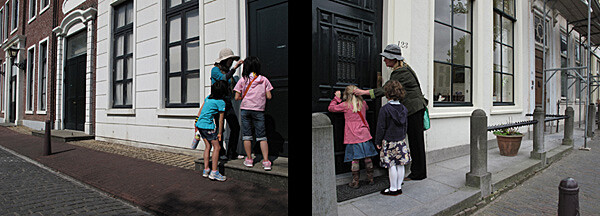

1. What Is Done to Us
2004 saw perhaps the most symptomatic Dutch cultural event of the past decade: the death of André Hazes, a chubby middle-aged singer of sentimental songs with dubious rhymes. A true Jordanees—the Amsterdam equivalent of the cockney—Hazes in a sense stood for a lost world. By the 1990s, the inner-city white working class had largely left Amsterdam for suburbs and new towns such as Almere, which is one of the cities where Geert Wilders’s PVV now has its strongest supporters. Hazes’s death sparked an unprecedented, almost Diana-like national mourning, with a service taking place in the Ajax football stadium, where his coffin stood in the center of the field. The crowd was ethnically homogenous, and it seemed as if his death marked an opportunity to turn back time. Recent television shows such as Ik hou van Holland appear to go out of their way to recreate the Hazes experience on a weekly basis, reducing Holland to a studio set of tulips and windmills in which immigrants do not exist, or at least not in numbers exceeding one. In architecture and urbanism, a similar tendency manifests itself in the reintroduction of historical motifs in a country long marked by modernism; new developments are modeled on “old Dutch towns” without any of these towns’ social and functional differentiation. As quasi-gated communities for the upper middle class, such settlements create symbolic (and sometimes literal) barriers between the nuclear family and the surrounding, threatening world. Barbara Visser’s double slide projection East/West (2009), which juxtaposes photos taken in the Huis Ten Bosch theme park in Japan with similar scenes recoded in Holland itself, makes for an insidious montage that draws out the imperfections of the Dutch “model” vis-à-vis the Japanese copy, even as it appears to conflate both in a single simulacral haze.
Having a way with words is part of the demagogue’s job description, and there is no denying that Wilders meets the requirements. One of his famous expressions is that (the subsidizing of) art is just a “leftist hobby,” one of a number of elite pet projects.4 Scrapping art subsidies would ensure that no more money is taken from “the people” by sinister left-wing elites. While art is being disparaged, the term culture has met with a more positive fate, being intimately connected to that other fetish, “national identity.” Art projects that are seen to somehow attack “our Dutch culture” or “our national identity” can count on vitriol. In a reversal of Carl Andre’s dictum that “art is what we do” and “culture is what is done to us,” the contemporary populist imagination regards art as what is done to us while culture is what we do, or rather: what we simply are. Strictly speaking, this means that culture would need to be defined without having recourse to art at all. In fact, it is usually not that art as such is opposed to culture, only contemporary art: the good art lies in the safe and idealized past, in the golden age.
From the Fortuyn years to the Wilders era, a discourse on national identity and on “Dutchness” has gathered pace, and some art historians have in fact long been in the avant-garde of reaction. For years, the Print Room of the Rijksmuseum (the temple to Dutch art and culture par excellence) has been supplementing its holdings of seventeenth-century graphic art with contemporary etchings of obscure local artists who are seen as continuing some quintessentially Dutch tradition of craftsmanship and realism. Among those that are too urbane to follow this course, the new spirit of cultural nationalism still manifests itself clearly. An art journalist who also distinguished himself as the author of several creepy sexist digs at Stedelijk Museum director Ann Goldstein in self-proclaimed “quality paper” NRC Handelsblad published a heavily publicized book on eighty Dutch paintings from the fifteenth century to the present that seems only too pleased to profit from the current climate, in which essentializing definitions of Dutchness are big business.5 Among the intellectual precursors for such publications are the writings and exhibitions of Rudi Fuchs, who since the late 1970s has been engaged in essentializing cultural differences, positing apparently completely incompatible “Nordic,” “Middle-European” and “Latin” traditions, and constructing oddly looped narratives of Dutch art in which Jan Dibbets became Saenredam’s and Mondrian’s “genealogical friend,” and Karel Appel Rembrandt’s.6 A stern letter sent by Hans Haacke to Fuchs in 1980, in which the artist made a well-argued case against Fuchs’s recycling of tropes from nineteenth and early twentieth-century cultural nationalism, obviously had very little effect.7
In a climate in which an identification of Dutch art with realism and traditional craft is virulent, the Frisia Museum in Spanbroek met with considerable echo. Later renamed Scheringa Museum, this private institution dedicated to modern and contemporary “realist” painting was founded by Dirk Scheringa, owner of DSB Bank, a bank specializing in subprime loans.8 In 2009, when the bank went into bankruptcy, a creditor—the marginally more reputable ABN AMRO bank—had the collection repossessed, leaving behind empty white cubes and orphaned wall texts and labels.9 If the art that is advertised as contemporary realism generally offers images that comfort by being legible, the museum’s empty spaces with their traces and inscriptions frustrate any facile collapse of the visible into the legible. Certainly, they have come to stand for the financial crisis, but the images of the voided museum cannot be explained by this alone.
Supporters of the museum and their children covered these white walls with graffiti. One text, spanning a corner, was particularly apt: “Dit is realisme,” this is realism.10 Perhaps unwittingly, this sentence suggests that the real “realism” would today be an art dealing with the concrete abstractions of today’s financial capitalism. And perhaps such an art begins with such a pithy sentence; a sentence in the corner of an empty white cube, in a space always redolent with potential images, a space in which elites and their populist others can come to terms with their own implication in capitalist realism.


2. Lubrication and Autonomy
In 2003, the Dutch pavilion at the Venice Biennale was home to a group show called We Are the World, curated by Rein Wolfs. After the rise and fall of the anti-Muslim populist Pim Fortuyn, whose murder rocked the country in 2002, We Are the World appeared to many observers as an attempt to restore Holland’s public image as a country of multi-culturalist tolerance. To be sure, artworks such as Carlos Amorales’s sweatshop investigated the complexities and inequalities of globalization, but the cumulative effect—helped by the feebly ironic title—seemed to make sure that any antagonism became just more proof of Holland’s capacity for accepting difference in what can be seen as an attempt to restore a damaged brand.11 In the 1980s, a Christian-Democratic minister for culture famously called culture a “lubricating jelly” for international business transactions, making explicit what was and is still an important element in the Dutch state’s sponsorship of art.12 Meanwhile, this sponsorship is being cut back by the new government, sparking a protest campaign that capitalized on the middle class’s aversion to more expensive theater tickets while brandishing a familiar blend of social-democratic and market-liberal reasons for proving art’s social and economical usefulness.
In the neoprovincial climate of the new century, museums such as Boijmans Van Beuningen in Rotterdam and the Gemeentemuseum in The Hague are run by cultural managers who know how to produce blockbusters, but under whose directorships the institutions have stopped playing any productive role in contemporary artistic and intellectual life. As a sign of the times, the director of the Gemeentemuseum stated that art critics should be obliged to mention a show’s sponsors in their review—a statement most certainly not made in the spirit of institutional critique, though such a reading could be interesting.13 What such a major museum—which is still major in terms of their holdings—offers its audience is a mix of brand names, shows in the “From Picasso to Mondrian” vein coupled with the likes of Pipilotti Rist, providing a prepackaged frisson of international culture while blocking any engagement with either current art practice, developments in art history, cultural theory, or social debates.14
Meanwhile, contemporary art in recent years has witnessed a curious Polder debate sparked by the works and texts of artist Jonas Staal. Staal observes that the autonomy of art, which has always been lauded by the established political parties in the Netherlands, in fact becomes a form of propaganda for the system that enables and identifies with this art. As soon as art’s autonomy is institutionally lauded, it is thereby undermined. This is hardly an original lesson, being perhaps the fundamental point of the critique of Greenbergian modernism and its cold war collusion with US politics since the late 1960s. However, Staal goes on to argue that propaganda for “democracy” is in fact good propaganda because democracy is a “good ideology,” being based on debate and negotiation. Staal advocates artistic “embeddedness” in political parties and the political process, which would create an art that he dubs “post-propaganda,” since it engages actively in the political process rather than merely serving as advertisement. In fact, this art is truly post-political propaganda, since Staal remains within an idealizing understanding of “democracy; and a formalistic definition of politics—rather than a broader and more substantial understanding of the political.”15 Tiers Bakker has criticized Staal for only engaging with the “software of art and politics”; the superstructure, while neglecting the real, substructural conflict over the means of production.16 Staal’s restrictive notions of politics and art do indeed turn him into Wilders’ court jester, as Bakker puts it, though in his eagerness to criticize Staal’s idealist conception of “democracy,” Bakker runs the risk of perpetuating an all too undialectical bashing of the superstructure as being unreal and irrelevant. Not only does the “software” merit active engagement, but some of the most important “superstructural” activities integrate their own substructural “base” into their very fabric so as to question and intervene in it.
The insights of the late 1960s and early 1970s into the ways in which claims to autonomy were undermined by ideological instrumentalization and the reduction of modernist abstraction to a specialist line of commodities has led to institutional critique’s investigations into cultural workers’ heteronomy. Precisely by doing so, institutional critique ultimately pursued an autonomy that dared not speak its name. A second generation—above all, Andrea Fraser—focused increasingly on the subjected subject in relation to the institution that partly shapes it. Brian Holmes has argued that this art bespeaks a “deep confusion between Weber’s iron cage and Foucault’s desire ‘to get free of oneself’,” resulting in “a governmentality of failure, where the subject can do no more than contemplate his or her own psychic prison, with a few aesthetic luxuries in compensation.”17 But a different interpretation of this art is possible, and, I would argue, more productive: it can be seen as paving the way for practices that follow Fraser’s “embodied” institutional critique in their investigation of the affective programming of the subject, while refusing to situate this subject only within a limited set of institutions.
Writing about a discussion with Phil Collins in one of the cars of his Autokino in Berlin, Hito Steyerl writes: “In a very low voice—as if anybody could have heard us—we were discussing labor conditions, curatorial rip offs, freelance bondage, contemporary art slavery—in one word: class struggle. Or rather the desire for it.”18 Superstructural conflict, then, is right here, though her last proviso is of course a crucial one. The entanglement of artists and other cultural producers in economic and political structures and inequalities that affect them (but that also affect others to a far greater degree) necessitates an embodied, enacted critique that goes beyond a fetishistic focus on an ultimately narrow set of institutions, either in the art world or in academia.19 In this sense, the Autonomy Project developed by the Van Abbemuseum and a number of art schools and universities is among the most urgent cultural and intellectual projects in Holland (and Europe) today.20 Bringing together art and art history students, the Autonomy Project offers space for collective reflection on operating within situations where autonomy is always already a charade, always already ideology, a front for wealth redistribution in a stagnant economy. The attacks by Wilders and his ilk can easily lead to a retreat to self-serving defense of art as being intrinsically good and noble; in fact, what is needed is a far more rigorous critique than anything populism can offer.
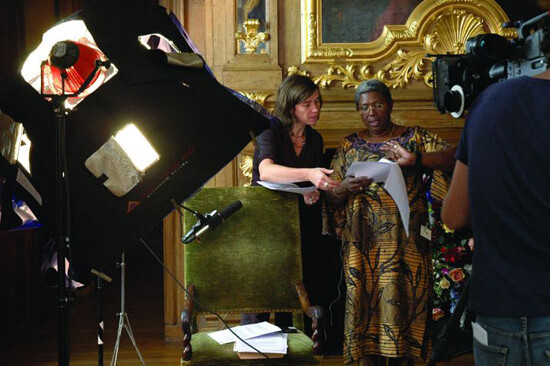

3. What We Do
Released last fall in Dutch arthouse cinemas, Allan Sekula and Noël Burch’s film The Forgotten Space was presented explicitly as “a Dutch film”—presumably because it was largely funded by Dutch organizations. Originating from a commission by SKOR, the Dutch foundation for public art, The Forgotten Space is a cinematic extension of Sekula’s Fish Story.21 The film takes the form of a montage of sequences from various ships and port towns as well as their hinterlands, effecting a cinematic map that joins the Betuwe in Holland to Shanghai and LA, and to the multi-ethnic crews on container ships. The shipping container is the film’s real protagonist, affecting the lives of people in disparate (and sometimes desperate) situations, an agent of abstraction that acts in highly concrete ways.
After the Dutch premiere at the Nederlands Film Festival, an elderly audience member disparaged the film as exemplifying “an old-fashioned sort of political critique.” It is a rhetorical move familiar from the Dutch press, which generally seem intent to convey that it is political engagement as such that is old-fashioned, since positive examples of such engagement are rarely given. Of course, it is perfectly legitimate to question the means used and the results achieved by Sekula and Burch with The Forgotten Space, but to brush aside a work of such formal and structural rigor, such breadth of scope and poignant detail, such elegant editing and harrowing interpellation, is not to judge it; it is, in fact, to be judged by it. Nonetheless, this leaves the problem of a failed encounter, of art’s uncertain and indirect efficacy.
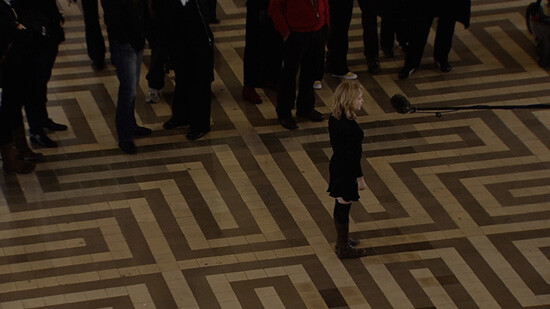

The true crisis in the Netherlands is the appearance of normality, the wide acceptance that things are not in any way exceptional, that this is a necessary phase, that the political barometer will swing back, and so forth. There are few, if any, public intellectuals and authors who provide substantial opposition to the prevailing discourse. Important artistic practices certainly get their small share of media attention in the form of reviews, but this format itself contributes to their neutralization, to their status as one consumer product among others. One such practice is Wendelien van Oldenborgh’s, whose video and slide works often engage with migration and with Holland’s repressed colonial past. Usually bringing together a group of people from diverse backgrounds to read and discuss historical texts, Van Olbenborgh uses this social montage and these switches between different modes of performance to generate video pieces that function precisely as reversed emblems, countering reductive nationalist readings of the glorious past marked by the “VOC mentality.”22
Location is important for Van Oldenborgh’s works, creating a kind of implicit geopolitical montage: Maurits Script, which assembles historical and current voices discussing Johan Maurits of Nassau’s tenure as governor in Brazil, was discussed in the Mauritshuis in The Hague, built with money made in Brazil and now a museum; the video installation No False Echoes was shot at the monumental, restored building of Radio Kootwijk, built in the 1920s in the middle of nowhere by Philips for radio transmissions to “Dutch India” (Indonesia). Among the performers was a rapper of Moroccan descent reading a stunning anti-colonial text by an Indonesian writer from 1913. In these and other ways, Van Oldenborgh’s works consistently counter the reduction of contemporary social problems to the intrusion of “the Muslim” into a hitherto mono-ethnic paradise. But these works are not “statements” that provide a handy synthesis. Rather, they remain complex and fractured social montages that, to an extent, form their own audience; the works themselves contain heterogeneous counter-publics whose performances, again, can be seen as judging the critics.
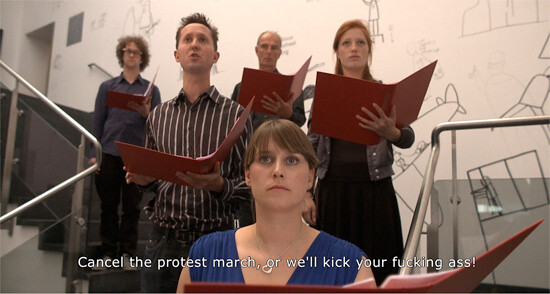

When art pieces have considerable echo, this echo frequently consists of so many waves of sound and fury. Much attention has been claimed by pseudo-events such as the court case for Jonas Staal’s De Geert Wilders Werken—an installation mimicking a certain kind of improvised memorial with photos, candles, flowers, and teddy bears, which the prosecutor saw as a threat directed at Wilders. Such a piece remains within the populist logic of orchestrated controversy; it generates Staalgewitter in the media, but does not in any way manage to produce a shift in the dominant imagery or discourse. A far more interesting project (that one hesitates to mention in the same breath) also became entangled in the populist production of “scandal”: Read the Masks, Tradition Is Not Given, developed by Petra Bauer and Annette Krauss as part of the Van Abbemuseum’s 2008 exhibition, Be(com)ing Dutch.
Read the Masks, Tradition Is Not Given was an installation and demonstration about the feast of Sinterklaas, celebrated on December 5, and more particularly focused on Sinterklaas’s assistant, Zwarte Piet (Black Pete)—played by white men in blackface. The overwhelming majority of Holland sees the celebration as entirely unproblematic in a society with a large black population, and Bauer’s and Krauss’s project was attacked vigorously, especially in online media, as a sinister attack on a sacred tradition essential to Dutch identity and culture.23 The feedback was so threatening that a protest march in the center of Eindhoven planned by Krauss and Bauer in conjunction with anti-racist and left wing groups, was cancelled. More recently, the affair was credited in a newspaper with actually strengthening the position of Zwarte Piet, since the unwarranted attack had helped the Dutch to acknowledge Piet as integral to their culture.24 Perhaps the project was a failure in that it allowed certain media to present it as being the project of “two foreign artists” (Krauss has lived in Holland for years, but that doesn’t count) and an elitist museum, rather than as a project involving multiple partners including Dutch-Surinamese activists and intellectuals. However, it is highly probable that more emphasis on the latter would have been effortlessly incorporated in the hate campaign, sustaining the myth of a monolithic national culture under attack from a sinister coalition of outsiders.
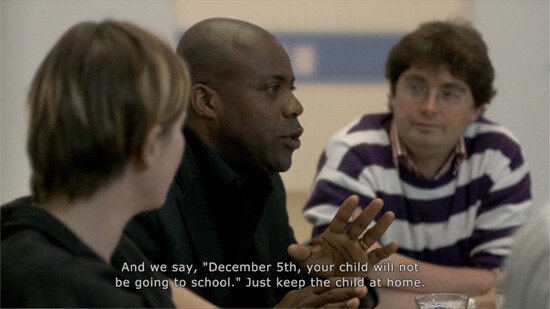

Contemporary European populism reduces history to a readymade myth that provides orientation, and critique is easily brushed aside. Ironically, many of the dominant myths claim to be fully on the side of the Enlightenment and secularism, opposing the sinister mythologies of religion in general and Islam in particular—with the reduction of the latter to a monolithic, quasi-personified entity being a sure sign of mythologization in action. It is perhaps not surprising that some contemporary authors attempt to define and develop counter-myths; reviving early twentieth-century projects from Georges Sorel to Georges Bataille, they search for critical mythologies that would provide more effective weapons for fighting populism than mere critique. It is a risky move, though one worth discussing if the aim is indeed to go beyond dubious strategies of “over-identification” to more challenging forms of mythopoesis. The latest issue of Open, the SKOR-funded “cahiers for art and the public domain,” is productive in this regard, though any serious engagement with artistic practice unfortunately seems to have fallen by the wayside. The issue contains a selection of emblematic images highly suggestive of the function of images in contemporary populism, but offers little discussion in the way of visual strategies.25 If mythology has long been associated in Western thought with a condensed, “plastic” use of language, with a surplus of visual and a lack of analytical qualities, what of the contemporary use of images—such as those of veiled women poised to represent the “radical other”—that actually reduce the visible to something approaching instant legibility?
The complete bankruptcy of the wider public sphere, the death of conventional intellectual and political debate, can make the “inner immigration” of dissidents in Nazi Germany seem like an attractive option. However, there is a third option, exemplified in different ways by some of the above examples: the creation of small constellations, of social montages that act on the basis of sober appraisal of the failures and deadlocks that mark the present situation. In contrast to what a familiar objection would be, this would not amount to an instrumentalization of either art or theory and criticism. In fact, it is the only chance at realizing something that might justifiably be termed autonomy: an autonomy that uses existing structures (in academia, in the art world, and elsewhere) by temporarily occupying their interstices. As a German expression has it: we don’t have a chance, and we must use it.
See also Sven Lütticken, Idols of the Market: Modern Iconoclasm and the Fundamentalist Spectacle (Berlin: Sternberg Press, 2009).
“Liberal” in European politics is obviously not identical to the term’s usage in the US. The most basic principle of European liberal parties is “free market” politics, which may be combined with more or less progressive agendas. In the Netherlands, D66 (a party long held in favor by cultural bureaucrats) is in a sense the prototypical “third way” party, advocating liberal politics with a hint of social democracy, as well as more direct democracy and transparency. The VVD is essentially hardline market-fundamentalist, though some of the party’s positions on issues such as gay marriage would count as pinko subversion by US standards.
When presenting his election program, Wilders presented this list of left-wing hobbies: “Het kabinet moet fors gaan snijden in al die linkse hobby’s zoals de miljarden die worden uitgegeven aan de Europese Unie, ontwikkelingshulp, milieu- en kunstsubsidies, Vogelaarwijken, inburgering en ga zo maar door.” See Margreet Fogteloo, “Dag linkse hobby’s,” De Groene Amsterdammer, October 6, 2010, →. For a genealogy of the expression “linkse hobby,” see →. During a parliamentary debate on culture on December 13, PVV parliamentarian Martin Bosma accused journalists of creating the false impression that the PVV considers art to be a left-wing hobby, claiming that it is instead the subsidizing of art that is the hobby in question. “Bosma: PVV vindt kunst geen linkse hobby” De Pers, December 13, 2010, →.
Hans den Hartog Jager, Dit is Nederland. In tachtig meesterwerken (Amsterdam: Athenaeum - Polak & Van Gennep, 2008). For Den Hartog Jager on Goldstein, see ‘Droomkandidaat’, NRC Handelsblad, July 10 2009; “Vernieuwd Stedelijk lost verwachtingen niet in,” NRC Handelsblad, August 27 2010.
René Pingen, Dat museum is een mijnheer. De geschiedenis van het Van Abbemuseum 1936-2003 (Amsterdam: Van Abbemuseum, 2005), 382; also 369–374.
Hans Haacke, Letter to Rudi Fuchs, July 27 1980, Van Abbemuseum archive. The letter was displayed in 2007 in one of the museum’s Living Archive presentations, ‘Wo stehst Du mit Deiner Kunst, Kollege?’
See for instance “Plans A to Z fail for DSB Bank,” NRC Handelsblad, October 19 2009, →.
“ABN Amro Secures Scheringa Museum Collection,” NRC Handelsblad, October 21 2009, →.
I know this inscription from a photo taken by Vivian Ziherl of De Appel’s Curatorial Training Program.
A withering review by Camiel van Winkel was published in De Witte Raaf, no. 104, July-August 2003.
For a contextualization of Brinkman’s oft-quoted remark that art is the glijmiddel of the economy, see for instance →. After years spent as an influential lobbyist for the construction industry (see for instance →), Brinkman is becoming more active in the CDA again, vocally supporting the cabinet while complaining that its treatment of the arts is a bit “rough.” Brinkman is seen as being among a number of CDA grandees who want to win back terrain from the PVV by steering the party in a more conservative direction.
“Sponsors verdienen ook applaus,” Trouw, February 10 2009, →.
It should be noted, however, that the Gemeentemuseum occasionally puts on serious exhibitions of early twentieth-century artists, even if it does not manage to position them discursively.
Jonas Staal, “Post-Propaganda. Inleiding,” in HTV De IJsberg no.82 (February–March 2010) →.
Tiers Bakker’s response to Staal is at →.
Brian Holmes, “Extradisciplinary Investigations. Towards a New Critique of Institutions” (2007), →.
Hito Steyerl, “The new L-word is labour. Some thoughts on Peter Weiss and Auto-Kino!” (2010).
For practical reasons, the issue of the financial and ideological pressure brought to bear on Dutch universities – on faculties, staff and students alike, though in different ways – must fall outside the scope of this essay.
See also my essay “Acting on the Onmipresent Frontiers of Autonomy” in To The Arts, Citizens! (Porto: Serralves, 2010), 146–167, which grew out of my involvement in the Autonomy Project.
See →.
The VOC was the Dutch East India Company; in 2006, then Prime Minister Jan-Peter Balkenende lauded the enterprising “VOC mentality,” presenting it as a model for contemporary Holland for which he was rondly criticized because of the VOC’s role in colonizing and exploiting Indonesia.
See the comments on the website GeenStijl, owned by the newspaper De Telegraaf: →.
“Sinterklaas heeft wind in de zeilen,” Metro, December 11, 2010, →.
The Populist Imagination, Open no. 20, (2010).

